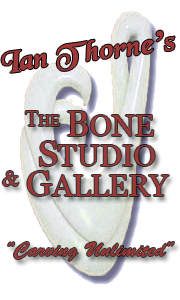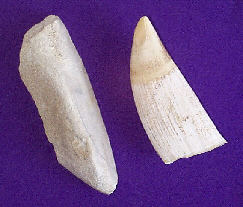
The Bone Studio and Gallery ... 
Bone and Whalebone
Bone
One of the premises I have always worked under is
"It's not what can you carve, it's what can't you carve?"
The answer being pretty close to nothing. I've even seen some amazing things carved out of toothbrush handles! It's a massive task to give detailed information on everything that has ever been hacked into by someone with a chisel or a chainsaw ... but here goes!
The following is a brief description of what you can carve:
Beefbone
Where to find bone?Get fresh shin bones (beef -- try a local farmer or butcher) and scrape clean inside and out. Wash in detergent. Stew gently 1/2 hour in detergent and nappy (diaper) cleaner. Soak two days then wash and dry. Enjoy! |
Cleaned up shinbone from sturdy New Zealand cows provides the most accessible material for bone carvers. Whilst limited by its size, it has a uniform white finish much like ivory, little grain and holds detail readily. Students are taught with it and much high quality work has been produced from it. Not to be underestimated!
Whalebone
WhaleboneLike all New Zealand carvers, I am against the killing of any marine mammals and only use washed up material, usually quite old when found. Whales washed up in New Zealand become the property of the Department of Conservation and are then buried and then given over to the local iwi (Maori tribe) for distribution if and when this is deemed appropriate. |
Whalebone is the next most famous material for carving. Pendants and weapons were cut from it by the Maori and other island peoples around the world. Very useful for tools and other ornaments. I have come across a great variation in types depending on which part of the body is used and where it was found.
The characteristics of the various types of whalebone are as follows:
- Teeth
- Very hard to come by, this whale ivory is beautiful, slightly translucent creamy yellow in colour with a fine grain that swirls around the centre and becomes whiter on the outside of the tooth. It should only be used for making special pieces -- it was considered the best material for making "healing taonga." The largest teeth come from sperm whales.

- Jawbone
- The largest and most commonly used whalebone, this has a greyish colour and a lot of grain -- and a lot of small holes made by blood vessels. Whalebone were or patu were second only to jade weapons in pre-European Aotearoa (New Zealand).
- Ribs
- Similar in texture to jawbone but they are often hollow/porous inside and this limits the size of the piece. Ribs are quite soft so they don't hold much detail. Ribs are more readily available but often overlooked as carving material.
- Shoulder
- Shoulder is a less known about piece of the skeleton for carving. Great variations in quality but some parts are good for sculptural work and other parts are good for pendants, etc.
- Vertebrae
- These are more for show but can be used for sculptural work as they are large, porous and easily worked.
- Fossilisation
- This, for want of a better term, is what happens to the bone if it is left buried in the mud after being washed up onto a beach. After a long time (100 years or more), it absorbs minerals from its environment and becomes very hard and stone-like. I have jawbone and shoulder with peach, bule, green and cream colours through it. The colour depends on whether it is washed up on a beach or a harbour. Similar variations are found in the rib bones, again dependent on where they are found.